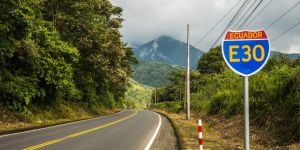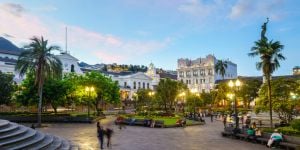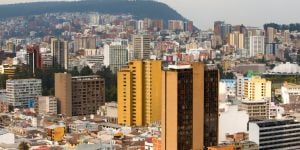Preparing to Take the EC Drivers Test
Last activity 27 July 2023 by Mr. Barley
4585 Views
43 replies
Subscribe to the topic
Post new topic
That would be the Examen Teórico required of all new Gringo drivers in La República.
It's a 20-question multiple-choice test offered up by ANT, La Agencia Nacional de Tránsito, the Ecuador DMV. The questions come from among a bank of hundreds of questions, some of which are specific to license class A, B or other.
Sample tests are available online at the ANT website www.ant.gob.ec
Anyway, here are 10 things I learned during my first session preparing for the examen...
10. Gringos who plan to drive regular cars should prepare for the test for license class B. Class A is for those who would dare to risk their lives riding a motorcycle in Ecuador. There's a chart at the ANT site for would-be drivers of trucks, executive taxis and funny cars. 
9. A common question on the class B demonstration exams has to do with when to check your oil. The correct answer is when the car is horizontal and the engine is cold.
8. ANT wants to persuade motorists that their kids should ride only in the back seat so as not to distract the driver. That's in another frequent question.
7. For some reason, test takers are supposed to be able to distinguish between the non-verbal road sign designs for a karaoke, kayakkers and underwater excursions.
6. The sign with the big H is likely for hotel, not hospital. This came up on only one sample exam, and the answer was hotel.
5. You may legally drive in Ecuador with a tinted, anti-glare windshield even if it compromises your vision, provided the tinting was originally done at a factory where it was legal to install. Bolivia, I'm guessing.
4. The hardest questions IMO require you to know (and by that I mean guess) the 2- or 3-part penalties that apply to such infractions as driving without a valid license or driving without using a seat belt, i.e. number of points, days of suspension and the fine which is based on a percentage of how much an Ecuadorian earns in a month.
3. Trucks may legally go at 100 kilometers per hour on highway straightaways, but only 60 kph on curved urban streets.
2. There are a lot of words on the Spanish-language-only tests that did not appear in your high school Spanish textbook and were not mentioned in your latest trip to the local fruit mercado. More on this in an upcoming post.
And the #1 thing I learned while preparing for this drivers examen....
1. Every question requires you to choose among three possible answers, so if you just guess at them, you may only get 6 or 7 correct. Some Gringo drivers told me you need to get 15 out of 20 correct in order to pass, but I don't see that confirmed on the ANT website.
cccmedia in Quito
While I was online trying to figure out which class of license car-drivers need, I asked one of the muchachos who works for my condo complex in Quito what is the difference between class A and class B licenses.
He readily explained that the class A license is for driving inside the city, and class B is for driving outside the city limits.
This seemed absurd on the face of it  , but I managed to keep a straight face.
, but I managed to keep a straight face.
If you have read Report #1 on this thread, you are already aware that this fellow's understanding of the EC drivers license differences left a lot to be desired.
cccmedia in Quito
cccmedia wrote:There are a lot of words on the Spanish-language-only tests that did not appear in your high school Spanish textbook and were not mentioned in your latest trip to the local fruit mercado. More on this in an upcoming post.
This is that upcoming post.
Bet you didn't know that bujías are spark plugs !
Siniestro, which in Spanish is an adjective meaning 'sinister,' can also mean an accident.
An ensanche means a widening of the road.
I also came across some words I had trouble finding at www.wordreference.com ... Maybe you can find these in your diccionario....
resalto angostamiento partierre redondel empalme lateral
Calzada means avenue and is a word that kept popping up. I suppose they could have used avenida instead. But that would have made things just a little too easy for Gringos. 
cccmedia in Quito
We hope you didn't think that the test that is the subject of this thread is the only test you'll need for your Ecuador drivers license.
If you didn't bring an unexpired drivers license from your home state along with a certified, apostilled driving record from that state, you may have to take a road test after subjecting yourself to a set of Spanish-language driving classes at an ANT-approved school.
Didn't bring the apostilled record and still want to avoid the classes and the road test? It's possible, but not necessarily inexpensive. Use the search function at the top of this page to visit the Car Lovers thread if you want to know more.
There's also a blood test at Cruz Roja clinic one block from the ANT office on Calle Pinto in Quito's Gringolandia, or at other clinic locations.
Let's not forget the hand-eye co-ordination / motor skills / mental capacity test conducted at an approved driving school location.
Remember to visit a notary to get some translations produced and authorized.
And you can pay an additional fee of $65 into ANT's account at Western Union or certain ANT-designated banks.
Just do it all like eating an elephant -- one bite at a time.
cccmedia in Quito
cccmedia: I have 2 licences. I have an A for my motorcycle that I got 3 years ago. Then there were 110 questions to study. The test is 20 questions and you can only miss 4. So you have to answer 16 right. My B licence is for my car. I got it 2 years ago. The questions to study for the test had increased to 220 questions. I have looked on the ANT site and now there are appx 312 questions with answers to study. You are correct that the tests are fully in Spanish. Both times I went for my licence I took other gringo friends to also take the test. They all barely even knew how to order in a restaurant. What we did was to sit and study for 3 hours or so reading the questions in Spanish and the answers for 4 days before we went to take the tests. I told them to memorize a key word in each question for recognition purposes. All 4 friends passed with perfect scores (20 right) If you go over the questions and answers for the 12 hours or so. Your short term memory will recall the answers when you take the test reading the questions and recognizing the answers. Me and my 4 friends are prime examples that it works. But in truth for me I am fairly proficient at Spanish as I am married to a Columbia. If a person can read Spanish the test is real easy. The reason is that out of the 3 or sometimes 4 answers to choose from, the correct answer is the only one that makes literal sense. It other words, the wrong answers are usually very nonsensical or just plain silly. Your post below is also correct as to the other requirements.
I have over 7000 miles on my motorcycle and 21000 on my car. We love to travel the highways and biways of Ecuador. There is so much beautiful scenery and towns to see. The 7000 on the motorcycle is all exploring on roads to different villages ect. within 75 miles of Cuenca. One of my friends that we rode all together with with died and 2 others have gone back to the states. I am looking for some more interested gringo riders I can share many wonderful sites and places to ride just around the 75 mile radius from of Cuenca. I have a 200 Ranger Luxury that looks like a small Harley. Plenty of power for here. With 4 valves and dual exhaust I would beat my friend with a 350 Enfield going up mountains. That Ranger model is now only $1606 at Coral. No typo! That is the price!! $70 more for the title and Reg and your ready to put the wind in your face!!
Cuenca boy wrote:I took other gringo friends to also take the test. They all barely even knew how to order in a restaurant. What we did was to sit and study for 3 hours or so reading the questions in Spanish and the answers for 4 days before we went to take the tests. I told them to memorize a key word in each question for recognition purposes. All 4 friends passed with perfect scores (20 right).
Great story. Phenomenal results! 
Here are the definitions I got from google translate which is sometimes not that "smart"
resalto=boss
angostammiento=narrow
redondel=arena
empalme lateral=side connection
it would not translate partierre as one word but tierra=earth and par=couple so go figure
Sample question....
Si usted sufre un desperfecto en su vehículo y tiene que inmovilizarlo al lado derecho de la calzada, ¿Debe poner los triángulos de seguridad?
Possible answers...a) no b) si, por la noche c) si, a cualquier hora
Translation: If you have a problem with your vehicle and have to immobilize it on the right side of the avenue, should you put down security triangles?
a) no b) yes, at night c) yes, at any hour
Correct answer....
(c)
Sue,your problem may be your not typing correctly! And your right that Google does not translate well and hardly does verbs. You might try spanishdict.com much better and you can put it on you mobile devise. First; Rialto is a verb meaning stick out, show up. Angostamiento another verb( no mm) means narrowing whereas Estrecho is narrow. Redondel is simple but takes a bit of imagination. It literally means Arena but it functionally means a round about. The round "arena" you go around where intersections meet. Empalme Lateral means side connection or street. You did get this one. The clue here is lateral. Are you sure of your spelling on Partir tierra means "from land" or Partir means leave,go,move away. The word you typed is not a spanish word. It looks french.Translators are not normally smart enough to guess the word if it is typed wrong. If you typed them as you did in your question you will not get even close. Be more careful and you will get better results.
Please note!!
I wrote before the method to success is to read the Spanish questions and answers over and over for 3-4 days just prior to taking the test. Short term memory will work to recognize the answers. I helped 4 different gringo friends of mine at different times and they all did it and all passed 100% It is hard to beat a proven method. DO NOT try to translate all of the questions and answers to English!!! It will just confuse you. One friend did that first and missed 17. After with my method he passed 100% The test is in Spanish not English!!! You can not use a translator person either. Good luck!
Common test questions.
The question about the security triangles has only come up once in the sample tests.
Other questions pop up frequently.
In this post and the ensuing one, here are two examples of common questions....
Si en una curva el vehículo se inclina demasiado deberá revisar principalmente....
a) el labrado de los neumáticos
b) los amortiguadores
c) la barra estabilizador
Translation....
If on a curve the vehicle tilts too much you should mainly check....
a) the inscription on the tires
b) the shock absorbers
c) the stabilizer bar
Correct answer....
(c)
¿Cuál es la razón principal por la que la distancia mínima entre el conductor y el volante debe ser 25 cm?
a) Porque al sentarse a mayor distancia no tendría suficiente visibilidad
b) Porque es la distancia de acción de airbag a explotar
c) Ninguna de los anteriores
Translation....What is the main reason that the mínimum distance between the driver and the steering wheel should be 25 centimeters?
a) Because when seated at long distance you wouldn't have enough visibility
b) Because it is the distance it takes for the airbag to deploy fully
c) None of the above
Correct answer:
(b)
.
Cuenca boy-
My knowledge of French (which is pretty good) is unfortunately always going to affect the ability I have to learn Spanish. You're right about "partir". If you look up "go" in a fr/.eng dictionary there is almost a whole column
I do listen to Spanish radio stations in the car just to hear the sound of it and am starting to be able to read it. I study out of a Latin American Spanish book
If I want to translate a whole piece of text bing.com is pretty good although not smooth
Sue; no translator can properly conjugate verbs with the 26 different ways in spanish. They can not get the masculino feminina right either. My Colombian wife told me there are no specific rules for Masculino feminina. She said you have to be born in Latin america to ever get it totally right.
The best translator I have found so far is spanishdict.com. Still not perfect but better than most others.
Partir is one of 28 ways to say go in spanish. It can be confusing.
You said you listen to the radio in your car. So, you are driving here without a licence? You can legally do that for 6 months after you receive your resident visa and cedula. They set up many road stops/checks usually right out of town to verify licence and valid matricula (registration). You run the risk of having your car impounded if you are not legal. I have seen that happen.
If you study as I suggested you will pass the test. My friends and I have proven that it works.
Good luck
Yeah there are so many ways to conjugate French verbs as well but you can get by without knowing them all. The masculine/feminine in Spanish seems to have more exceptions than French but the more you practice speaking the better you get
No, I am not in EC so I'm driving with a license here in the US. I am not even sure that I would get a license in EC if I ended up living in Quito or Cuenca. Maybe after awhile. The traffic sounds pretty crazy and the cost of a vehicle is also expensive. It sort of depends on how much I sell my car here for and how much after I have set up a place to live
CCC you had a big hassle because of an expired US license. Is there anyway you can get around that? What about the international license?
suefrankdahl wrote:CCC, you had a big hassle because of an expired US license. Is there anyway you can get around that?
Once your U.S. drivers license is expired, you are at the mercy of the Ecuadorian system.
To drive legally after several months in Ecuador, an EC drivers license is required. To obtain it without a still-valid drivers license from the U.S., you must then take the onerous Spanish-language drivers-ed classes and pass the road test, in addition to fulfillment of the regular requirements, including the examen teórico, official name of the test that inspired this thread.
My Pennsylvania license does not expire until October. For more on how to get the most out of your unexpired license, revisit the Car Lovers thread via the searchbox atop this page. There's also more information there about the DL requirements.
cccmedia in Quito
suefrankdahl wrote:What about the international license?
I don't believe there exists a valid document known as an international drivers license.
There is an international permit that might help you obtain a rental car in some countries.
In Ecuador, however, you have the legal right to drive on your unexpired U.S. drivers license while you are here on the customary tourist stamp.
So don't waste your time on the international permit when you could be using it to take more sample exams online, preparing for your actual examen teórico. 
cccmedia
More common questions.
El ajuste del asiento debe:
a) facilitar el aceso a los mandos y dispone de buena visibilidad
b) ser lo más alto posible por ver mejor hacia delante
c) estar lo más adelante posible para poder acelerar mejor
Translation....The seat should be adjusted to....
a) facilitate access to the controls and make available good visibility
b) be as high as possible to see ahead better
c) be as far forward as possible to be able to accelerate better
Correct answer....
(a)
.
El dispositivo de seguridad para evitar el efecto látigo sobre el cuello se llama...
a) airbag
b) cinturón de seguridad
c) apoya cabeza
Translation....The security device for avoiding whiplash to the neck is called...
a) airbag
b) safety belt
c) head support
Correct answer....
(c)
Tricky Questions.
Two cars approach the no-signals intersection at the same time at a 90-degree angle to each other on different roads.
In some sample tests, the question asked is which car has right of way.
In other sample tests, the question asked is which car should yield (ceder el paso.)
So read carefully.
Another long question appears in two forms which are identical except for one word, which word changes the correct answer.
En un siniestro de tránsito el uso de cinturón de seguridad en velocidades bajas podría reducir el número de fallecidos en un....
a) 0.4
b) 0.75
c) 0.6 (the correct test-answer)
Translation....In a traffic accident the use of a seat belt at low speeds could reduce the number of deaths by...
(same numbers as Spanish-language example)
Analysis.
First, does this question-and-answer even make sense?
The choices are not percentages and are not said to be based on incidents per XXX number of accidents.
Further complicating this is that on some sample tests, the word bajas (meaning "low") is replaced by altas (meaning "high").
This changes the correct answer to 0.4, which could be viewed as a counterintuitively low number.
cccmedia in Quito
After looking at it I think the decimals could be read as percentages which are parts of 100... 0.4 would be 40/100 or 40% and likewise 0.6 would be 60/100 or 60%
In some ways it does make sense that if you were going at a lower speed the seatbelt would be more effective than at a higher speed
My Spanish is weak and poor. I passed the online Spanish language test easy and passed it with 100%. with no studying or prep. Correct answers seemed obvious.
Smitty must be a savant, or else lucked into the occasional test that doesn't require you to know all three penalties for certain infractions (points, fine, suspension) and the moderate and maximum speeds for livianos y motocicletas on urban streets, peripheral streets and carreteras.
Based on the sample tests, I doubt 1 in 100 Gringos could ace the test, 20 of 20, with no prep and almost no Spanish.
cccmedia in Quito
Passing the examen teórico without knowing Spanish.
This is altogether possible as every one of the several hundred questions, along with the correct answers, is posted on the www.ant.gob.ec website.
To find these questions, click on Banco de Preguntas at the site's welcome page.
Click on Descargar to navigate toward the questions.
Choose B for class of license if you plan to drive an ordinary car, or A if you are a moto guy or gal.
Figure out which are the toughest questions and concentrate on these in your study.
cccmedia in Quito
The two exams.
As mentioned earlier in this thread, there are two off-road exams required to succeed in the EC drivers license program....
The examen teórico -- get 16 of 20 right and you pass -- which, of the two, is the exam that lends itself to home study. This you take an an ANT office. We'll discuss how to arrange for this exam in the ensuing post.
The examen psicosensimétrico (let's call it psi test) measures hand-eye co-ordination, motor skills and mental capacity.
Of the two exams, you will take the psi test first, since passing it is a pre-requisite for being allowed to take the other exam.
You take the psi test at any ANT-approved driving school in Ecuador. The current fee for this test is $20, payable at the school.
At a popular school in Quito, ANETA at Eloy Alfaro and Berlín, you can show up any time the school is open, pay the fee and take the test. If others are there for the test, just wait your turn.
Bring your Ecuadorian ID, your original foreign license, your blood-type card and the fee.
cccmedia in Quito
Scheduling the examen teórico.
This is done online.
Go to www.ant.gob.ec and choose the Turno option. This means your "turn" to take the exam ... your appointment time.
You will choose the city, the location and the class of license.
The system will generate a time and day for your appointment.
If that appointment can be canceled or changed, I'd like to know how. There is no obvious way to do anything but accept the scheduled time.
You are expected to arrive five minutes early to have your paperwork checked for completeness and correctness. If the paperwork is right, you will be allowed to take the exam.
If you pass the exam with 16+ answers correct, this can be the successful end of the journey... with your reward being an Ecuador drivers license.  You will have the legal right to drive anywhere in La República!
You will have the legal right to drive anywhere in La República!
So bring everything that is required for licensing to the exam appointment. Since the list of requirements adheres to the #1 rule in Ecuadorian bureaucracy -- namely, all rules are subject to change -- make sure you are fulfilling what's called for on the updated, printed list issued by ANT.
Don't be fooled by any unsubstantiated rumors that ANT has supposedly dropped its requirement that you get an apostille for your state-certified, notarized driving record. You probably still need to get that.
cccmedia in Quito
Taking the first of the two exams -- the examen psicosensimétrico.
This hand-foot-eye series of visual and physical challenges is given at the authorized driving-schools, including the one I have become familiar with, ANETA in Quito on Avenida Eloy Alfaro.
It's conceivable the test may vary in some ways from school to school. The description of the exam is the one offered in September 2015 at ANETA.
Most of the equipment used is straight out of 1939, although there is a color monitor used for some of the testing. You sit at a table outfitted with a variety of gear, sometimes wondering what some of this stuff has to do with driving a car.
1. The reaction test. A simulated traffic light on the monitor turns directly from green to red -- no yellow light -- and your challenge is to switch from the accelerator pedal to the brake pedal as fast as possible, while the test-taker keeps telling you that you're doing it too slow.
2. The vision test. Folks raised in the U.S. will be familiar with this "standard" eye test. You have to recognize five letters per line in a total of nine lines, with a decrease in size of the letters from line to line. As far as I know, you have to know how to pronounce the letters in espanol. All instructions on all tests within the main test were given to me in Spanish.
3. Colors test. You have to identify a line of colors, i.e., rojo, verde, azul, rojo, amarillo.
4. Night vision test. On a mostly-dark screen, identify two items. The correct answers on my exam were ... algo triangular en amarillo ... círculo en rojo.
5. Tracing test. This was the strangest of the bunch. You hold a pair of gizmos, one with each hand, and have to trace a tricky diagram with a dull needle. The gizmos work in tándem. You are given plenty of practice runs before you do the main go-through.
The whole thing reminds one of the old TV show "Beat the Clock."
cccmedia in Quito
Key ítems to bring to the examen psicosensimétrico.
I ended up having to come to the ANETA testing center three times -- and almost a fourth -- because they didn't tell me what to bring, and I didn't pin things down enough. Perhaps this post can help you avoid going back and back and back.
Passing this test is a pre-requisite for qualifying to take the crucial examen teórico.
The first trip I brought my Ecuadorian ID. An ANETA guy told me that's not enough, I needed my U.S.-issued drivers license too .. or no test.
When I came back the second time, they looked at the Pennsylvania license and said there's not enough time left before expiration. That turned out to be false -- see the thread called Car Lovers for that story if you wish -- as you really should just need a currently-valid license from the U.S.
After clearing up that issue with my Quito attorney on the clock, I went to ANETA a third time and found out they needed to know my blood type, which had recently been confirmed at Cruz Roja as one of the drivers-license exchange requirements. I recalled that my type was type A. But then the ANETA lady asked me, was it A-positive or A-negative, and that was a stumper. So I just guessed: A-positive. I found out hours later that the guess was correct .. saving me from having to make a fourth trip to ANETA for the test.
At the end of the exam, they handed me a document with test results which I inspected.
¿Aprobado y ya? I asked. Approved and that's it?
Aprobado y ya, the jefa told me, confirming success. 
cccmedia in Quito
cccmedia wrote:Smitty must be a savant, or else lucked into the occasional test that doesn't require you to know all three penalties for certain infractions (points, fine, suspension) and the moderate and maximum speeds for livianos y motocicletas on urban streets, peripheral streets and carreteras.
Based on the sample tests, I doubt 1 in 100 Gringos could ace the test, 20 of 20, with no prep and almost no Spanish.
cccmedia in Quito
ccc he said the online test. It is different that the 1 page written test taken at the agency.
As fun as that all sounds, I think I'll stick to my policy of bending the rules... and by bending I mean totally ignoring.
Cuenca boy wrote:cccmedia wrote:Based on the sample tests, I doubt 1 in 100 Gringos could ace the test, 20 of 20, with no prep and almost no Spanish.
ccc said the online test. It is different that the 1 page written test taken at the agency.
.
I've been taking the on-line tests, three or four a day, to prepare for the Big Enchalada on September 11 (2015).
At this point, I've been routinely getting 18 to 20 correct out of the possible 20. You must get 16 correct to pass.
I wouldn't be passing these practice tests without knowing Spanish and without learning from the corrected tests the online system provides. Checking some words in an online dictionary post-sample-test has been helpful.
Some questions are easy and the answer can be deduced primarily from looking at a picture or diagram included. However, the fancy questions about obscure penalties for infractions .. and questions about the various speed limits on carreteras, perimetrales y vias urbanas appear on practically all the tests I have taken.
So I advise applicants to take the test seriously -- and prepare intensively using the on-line system that has been developed .. and continuing to improve their español.
cccmedia in Quito
jessekimmerling wrote:As fun as that all sounds, I think I'll stick to my policy of bending the rules... and by bending I mean totally ignoring.
If that means still driving on a valid EC cédula and an expired Washington State drivers license -- and still somehow talking your way past checkpoints and police stops -- you're one in 10,000, Jessie. 
Most of us mortals lacking war-zone experience just don't have the cojones for that method.
cccmedia in Quito
You can "bend" if you like! BUT if you get stopped in one of the many random road stops you run the chance of having the car impounded and going to jail! I know of 2 gringos who had that happen. Even here breaking laws has its consequences!!! I suppose you dont want to learn Spanish either???
Cuenca boy wrote:You can "bend" if you like! BUT if you get stopped in one of the many random road stops you run the chance of having the car impounded and going to jail! I know of 2 gringos who had that happen. Even here breaking laws has its consequences!!! I suppose you dont want to learn Spanish either???
I've been through dozens of traffic stops in Ecuador. es no problemo.
cccmedia wrote:jessekimmerling wrote:As fun as that all sounds, I think I'll stick to my policy of bending the rules... and by bending I mean totally ignoring.
If that means still driving on a valid EC cédula and an expired Washington State drivers license -- and still somehow talking your way past checkpoints and police stops -- you're one in 10,000, Jessie.
Most of us mortals lacking war-zone experience just don't have the cojones for that method.
cccmedia in Quito
Well, I did almost get the car impounded outside Esmeraldes. That was a tough bribe to pull off sneakily since there were 8 cops standing around.
Let us know when your luck runs out! It invariably will. Bribing here is illegal also. You may be lucky on that but it will be more time in jail when you get a cop that enforces the law. They are stinging more and more cops for taking bribes. It will clean up. Russian roulette!! I have 2 licences (A and B) and it was easy.
Good advise!!!!!!!!!!!!!! I totally agree. It is much better to obey the law than to be ignorant and not!! I wrote before that the way me and several friends did it was to study the questions and answers for 3-4 days before. You are doing the same on line. Kudos!!! Enjoy this beautiful country on the road. I have 7000 on my bike and about 30,000 on my car doing just that!! Legally at that!! Have a nice day.
Cuenca boy wrote:Let us know when your luck runs out! It invariably will. Bribing here is illegal also. You may be lucky on that but it will be more time in jail when you get a cop that enforces the law. They are stinging more and more cops for taking bribes. It will clean up. Russian roulette!! I have 2 licences (A and B) and it was easy. Why break the law just because you are lazy??
One man's laziness is another man's adaptation to local customs. I'm sure I will get unlucky sooner or later and come out the other end with an awesome/scary story about my week in an Ecuadorian jail. To each his own. I just don't sweat the small stuff.
I'm in the final days of preparing for the examen teórico, and came across the most humorous question yet on the sample tests. (I'll spare you the español on this one....)
As a pedestrian, you see the red pedestrian light beginning to flicker before you start to cross the street.
Do you ...
(a) Wait for the light to change back to green before crossing ...
(b) Run quickly to beat the light ...
(c) Walk to the middle of the street and stop there.
.
Articles to help you in your expat project in Ecuador
 Driving in Ecuador
Driving in EcuadorWhile public transport is prevalent country-wide and has a great reputation in Ecuador, you may choose to drive ...
 Food in Ecuador
Food in EcuadorWhat kind of food will you find in restaurants, cafes, and private homes in Ecuador? Many restaurants in Ecuador ...
 Work in Ecuador
Work in EcuadorEcuador is famous as a retirement haven. But you might not want to wait until retirement age to move there and ...
 Family and children in Ecuador
Family and children in EcuadorFamily is everything to an Ecuadorian. The extended family unit is the most important aspect of life in Ecuador, ...
 Opening a bank account in Ecuador
Opening a bank account in EcuadorA few years back, an expat would just breeze into an Ecuadorian bank, flash their passport and a bank account ...
 Healthcare in Ecuador
Healthcare in EcuadorEcuador, as a fast-developing nation, has laws that are constantly evolving, but one thing is certain: the ongoing ...
 The Working Holiday Visa for Ecuador
The Working Holiday Visa for EcuadorEcuador is truly a paradise for adventure and nature lovers, and thanks to the Working Holiday Visa program, they ...
 Leisure activities in Ecuador
Leisure activities in EcuadorYou have made it to Ecuador, now what is there to do in your free time? A lifetime in Ecuador isn't enough time to ...
Find more topics on the Ecuador forum



